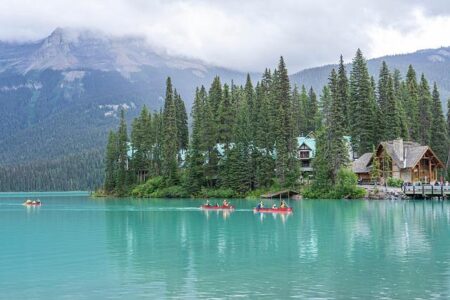In the remote reaches of Canada’s Arctic frontier, a series of rusting relics stand as silent witnesses to a tense chapter in Cold War history. Once pivotal components of a vast defense network designed to detect and deter nuclear threats, these aging installations reveal a forgotten era when the northern wilderness served as a frontline in the battle for global security. As modern technology renders them obsolete, these northern outposts offer a stark reminder of the geopolitical anxieties that shaped the mid-20th century and continue to influence international relations today. This article explores the legacy of Canada’s northern defense sites, their historical significance, and the challenges of preserving these enduring symbols of a bygone era.
Canada’s Remote Cold War Bunkers Reveal a Forgotten Nuclear Defense Strategy
Deep in the remote expanses of Canada’s northern territories lie a series of decrepit bunkers, once top-secret installations designed to serve as critical nodes in a vast nuclear defense network. These cold war-era fortresses, now reclaimed by nature and rusting in the harsh Arctic elements, stand as silent reminders of a time when global tensions demanded preparedness against a looming nuclear threat. Constructed during the height of the Cold War, these bunkers were equipped to monitor potential Soviet missile launches and coordinate emergency military responses, embodying a strategic vision that has since faded into obscurity.
Their design reflects a careful balance between function and survival, featuring:
- Reinforced concrete walls capable of withstanding blasts
- Self-sufficient power systems including diesel generators and advanced ventilation
- Integrated communication arrays linking remote outposts to command centers
- Living quarters intended for extended isolation during crises
| Feature | Purpose | Current State |
|---|---|---|
| Radar Arrays | Detect incoming threats | Non-operational, partially dismantled |
| Emergency Shelters | Protect personnel during attacks | Rusting, structurally compromised |
| Communication Hubs | Maintain contact with defense forces | Abandoned, obsolete equipment |
| Power Generators | Ensure continuous operation | Defunct, stripped of parts |
Decaying Infrastructure and Environmental Concerns Plague Northern Military Sites
Once pivotal components of Canada’s Cold War defense strategy, numerous military installations in the far north now stand abandoned, their structures succumbing to relentless Arctic elements. These outposts, designed to detect incoming nuclear threats, have become silent markers of a bygone era, but their deterioration poses a growing threat to local ecosystems. Numerous rusting fuel tanks, contaminated soil, and deteriorated buildings released hazardous substances long after decommissioning, jeopardizing delicate tundra environments and the health of indigenous communities.
Environmental experts warn that without immediate intervention, the consequences could be severe. Key concerns include:
- Soil and water contamination: Leaks from aging storage facilities have already been detected in nearby waterways.
- Wildlife exposure: Tundra species potentially ingest harmful pollutants affecting reproductive and immune systems.
- Structural instability: Collapsing buildings pose physical risks to cleanup crews and local inhabitants.
| Site | Year Decommissioned | Primary Contaminant | Current Status |
|---|---|---|---|
| Midnight Sun Base | 1995 | Diesel Fuel | Partial Cleanup |
| Polar Watch Station | 1987 | Lead & Asbestos | Ongoing Assessment |
| Frostline Radar | 1992 | PCB Residue | Abandoned |
Preserving History While Ensuring Safety Recommendations for Managing Abandoned Outposts
Preserving these remnants of Cold War-era vigilance requires a delicate balance between conservation and public safety. Many of these outposts, once staffed and maintained to deter nuclear threats, now stand derelict in remote, often harsh environments. To protect visitors and the integrity of these sites, authorities recommend implementing controlled access zones and regular structural assessments. The use of modern technology such as drone surveillance and GIS mapping can aid in monitoring deterioration while minimizing human interference. Educational signage and guided tours could also raise public awareness, highlighting the historical significance without compromising safety.
Addressing environmental hazards inherent at these abandoned locations is equally critical. Sites may contain hazardous materials like asbestos, lead-based paints, or residual fuel, posing risks to both wildlife and future visitors. A strategic plan prioritizing hazard removal alongside preservation efforts is essential. The following table outlines key recommendations for managing these outposts effectively:
| Priority | Action | Outcome |
|---|---|---|
| High | Hazardous material remediation | Eliminates health risks |
| Medium | Site structural assessment | Ensures physical stability |
| Medium | Access control implementation | Prevents unauthorized entry |
| Low | Interpretive signage installation | Educates public on historical value |
In Retrospect
As Canada’s northern relics of the Cold War continue to weather the elements and fade into obscurity, they stand as silent monuments to a tense era of global brinkmanship. These rusting structures, once vital components of a defense strategy against nuclear threat, now prompt reflection on both the geopolitical anxieties of the past and the evolving nature of security in the Arctic. Their preservation-or lack thereof-raises important questions about memory, history, and the enduring impact of the Cold War on Canada’s remote frontiers.




